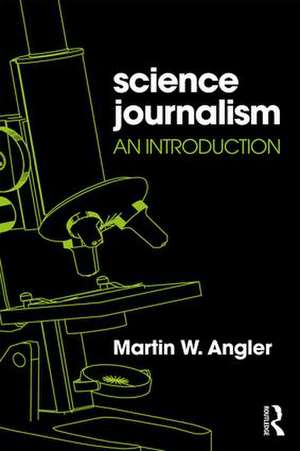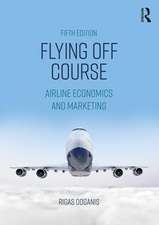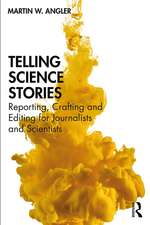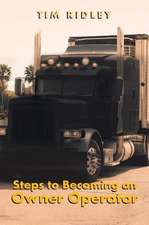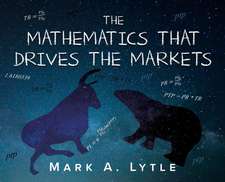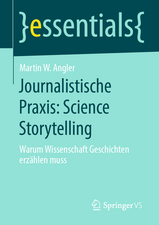Science Journalism: An Introduction
Autor Martin Angleren Limba Engleză Paperback – 7 iun 2017
Martin W. Angler, an experienced science and technology journalist, covers the main stages involved in getting an article written and published; from choosing an idea, structuring your pitch, researching and interviewing, to writing effectively for magazines, newspapers and online publications. There are chapters dedicated to investigative reporting, handling scientific data and explaining scientific practice and research findings to a non-specialist audience. Coverage in the chapters is supported by reading lists, review questions and practical exercises. The book also includes extensive interviews with established science journalists, scholars and scientists that provide tips on building a career in science journalism, address what makes a good reporter and discuss the current issues they face professionally. The book concludes by laying out the numerous available routes into science journalism, such as relevant writing programs, fellowships, awards and successful online science magazines.
For students of journalism and professional journalists at all levels, this book offers an invaluable overview of contemporary science journalism with an emphasis on professional journalistic practice and success in the digital age.
| Toate formatele și edițiile | Preț | Express |
|---|---|---|
| Paperback (1) | 304.61 lei 3-5 săpt. | +25.27 lei 7-13 zile |
| Taylor & Francis – 7 iun 2017 | 304.61 lei 3-5 săpt. | +25.27 lei 7-13 zile |
| Hardback (1) | 816.81 lei 6-8 săpt. | |
| Taylor & Francis – 6 iun 2017 | 816.81 lei 6-8 săpt. |
Preț: 304.61 lei
Nou
Puncte Express: 457
Preț estimativ în valută:
58.29€ • 62.33$ • 48.60£
58.29€ • 62.33$ • 48.60£
Carte disponibilă
Livrare economică 27 martie-10 aprilie
Livrare express 13-19 martie pentru 35.26 lei
Preluare comenzi: 021 569.72.76
Specificații
ISBN-13: 9781138945500
ISBN-10: 1138945501
Pagini: 362
Ilustrații: 7 Line drawings, black and white; 14 Halftones, black and white; 21 Illustrations, black and white
Dimensiuni: 156 x 234 x 27 mm
Greutate: 0.52 kg
Ediția:1
Editura: Taylor & Francis
Colecția Routledge
Locul publicării:Oxford, United Kingdom
ISBN-10: 1138945501
Pagini: 362
Ilustrații: 7 Line drawings, black and white; 14 Halftones, black and white; 21 Illustrations, black and white
Dimensiuni: 156 x 234 x 27 mm
Greutate: 0.52 kg
Ediția:1
Editura: Taylor & Francis
Colecția Routledge
Locul publicării:Oxford, United Kingdom
Cuprins
1. Introduction 2. Finding Science Stories 3. Pitching 4. Interviewing Scientists 5. Writing about Science for Magazines 6. Writing about Science for Newspapers 7. Writing about Science Online 8. Storytelling for Science Journalists 9. Facts and Figures 10. Investigative Science Journalism 11. Science Journalism in the Digital Age 12. Building a Career in Science Journalism
Appendix A
Index
Appendix A
Index
Recenzii
"Angler draws on his own experience and taps into a wide network of professional experts and scholars to provide an authoritative and comprehensive guide to the specialist field of science journalism. Extensively researched chapters cover practical tips on the journalistic process. These are underpinned by discussion of critical themes including communicating risk, notions of fake balance and statistical literacy."
Gary Stevens, Programme Leader, MA Science & Environmental Journalism, University of Lincoln, UK
"Finally, a comprehensive first-of-its-kind text on the essential tools and techniques of science journalism. Long awaited and lucidly written from a clear professional vantage point, Martin W. Angler’s book is a defiant rise up to those who believe in the gradual death of well-crafted science journalism."
An Nguyen, Associate Professor of Journalism, Bournemouth University, UK.
Gary Stevens, Programme Leader, MA Science & Environmental Journalism, University of Lincoln, UK
"Finally, a comprehensive first-of-its-kind text on the essential tools and techniques of science journalism. Long awaited and lucidly written from a clear professional vantage point, Martin W. Angler’s book is a defiant rise up to those who believe in the gradual death of well-crafted science journalism."
An Nguyen, Associate Professor of Journalism, Bournemouth University, UK.
Descriere
Science Journalism: An Introduction gives wide-ranging guidance on producing journalistic content about different areas of scientific research. It provides a step-by-step guide to mastering the practical skills necessary for covering scientific stories and explaining the business behind the industry.
Martin W. Angler, an experienced science and technology journalist, covers the main stages involved in getting an article written and published; from choosing an idea, structuring your pitch, researching and interviewing, to writing effectively for magazines, newspapers and online publications. There are chapters dedicated to investigative reporting, handling scientific data and explaining scientific practice and research findings to a non-specialist audience. Coverage in the chapters is supported by reading lists, review questions and practical exercises. The book also includes extensive interviews with established science journalists, scholars and scientists that provide tips on building a career in science journalism, address what makes a good reporter and discuss the current issues they face professionally. The book concludes by laying out the numerous available routes into science journalism, such as relevant writing programs, fellowships, awards and successful online science magazines.
For students of journalism and professional journalists at all levels, this book offers an invaluable overview of contemporary science journalism with an emphasis on professional journalistic practice and success in the digital age.
Martin W. Angler, an experienced science and technology journalist, covers the main stages involved in getting an article written and published; from choosing an idea, structuring your pitch, researching and interviewing, to writing effectively for magazines, newspapers and online publications. There are chapters dedicated to investigative reporting, handling scientific data and explaining scientific practice and research findings to a non-specialist audience. Coverage in the chapters is supported by reading lists, review questions and practical exercises. The book also includes extensive interviews with established science journalists, scholars and scientists that provide tips on building a career in science journalism, address what makes a good reporter and discuss the current issues they face professionally. The book concludes by laying out the numerous available routes into science journalism, such as relevant writing programs, fellowships, awards and successful online science magazines.
For students of journalism and professional journalists at all levels, this book offers an invaluable overview of contemporary science journalism with an emphasis on professional journalistic practice and success in the digital age.
